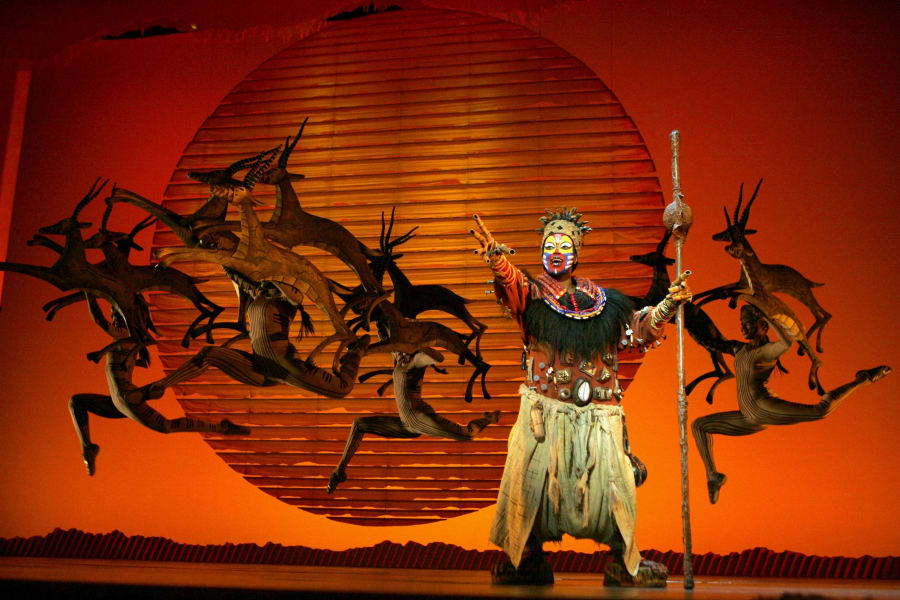DETROIT – After a sold-out run at the Opera House back in 2017, Disney’s The Lion King brings the Pride Lands back to Detroit for 2022.
Whether you’ve never seen it or you’ve seen it seven times (like myself), there’s a reason why the show has been running for the last 24 years and reigns as the longest-running Disney theatrical production. You might be thinking to yourself, “I already know the story. Mufasa dies, it’s so sad, blah, blah, blah.”
Recommended Videos
But you are wrong. Nothing compares to the Broadway version of the film. Don’t believe me? Here’s why you need to see it.
Immersive Broadway experience
The film was released back in 1994 and the show has been running since 1997, so there’s no plot to spoil. But the way the story is brought to life on stage happens in a drastically different way. From the moment the show starts, you’re already experiencing The Lion King in a completely different fashion.
During “The Circle of Life,” you’ll see some of the show’s biggest “animals,” some of which might walk down your aisle. The two giraffes you’ll see are 14 feet high, with each actor having to climb a six-foot ladder just to get inside the puppet, mount stilts and walk across the stage.
The show’s elephant, nicknamed Bertha by the back stage crew when it premiered in 1997, is the largest and longest animal in the show. It’s 13 feet long, 12 feet high and nine feet wide, and requires four actors to carefully walk her around and bring her to life.

Odds are, when you think of The Lion King, one of the most famous scenes that comes to mind is Rafiki holding up young Simba on Pride Rock to all of the animals bowing down below. By the way, that scene has been parodied numerous times -- even the Detroit Tigers do a “Simba Cam.”
Pride Rock appears five times throughout the show and is battery-operated to expand outward like an accordion to 18 feet wide at its fullest position onstage.
If you’re wondering how other scenes play out, such as how the wildebeest scene is brought to life, you’ll have to wait and see the show.
Melting pot of cultures
Animators of the original film visited Kenya in order to portray the most accurate depiction of African wildlife, but it was more than what meets the eye for the variety of cultures that culminate within the film.
The soundtrack and score shared just as important of a role. South African composer Lebo M. tied together the unique rhythms and chants of South African culture into the score composed by Hans Zimmer to make The Lion King stand out as one of Disney’s more diverse films.
Throughout the Broadway show, you’ll hear six different African languages either sung or spoken.
Percussion is one of the more integral aspects of South African music, and it’s no stranger to the The Lion King on Broadway. When you find your seat inside the Opera House, you’ll see two percussionists on the sides of the stage. Once the show starts, you’ll see them play throughout as the sounds of Africa are brought to life right before you. Instruments like the Djembe and Bongo drums act as a narrator to help tell the story.
The live symphony orchestra that performs below the stage and is hidden to the audience is the show’s invisible superstar. One of the most important instruments to the show is the flute. Fifteen different flutes from countries such as India and China are used throughout the show -- each one in its own unique way to represent a character or a specific setting.
One of the biggest challenges for director Julie Taymor was bringing the animals to life on stage, though It’s not just the animals that are personified through costumes.
Some costumes represent scenery and different environmental elements of the show. According to Taymor, every piece of cloth used to create the costumes in the show was hand-printed and painted. Much of the fabric, beads and other materials used to create the costumes were sourced straight from Africa.
As for the creation of the puppets and masks, there’s inspiration from Japan, Indonesia and Africa. In fact, it took Taymor and her team more than 37,000 hours to build the puppets and masks for the show.
Taymor created what she calls the “double event,” which shows both the actor and puppet. Most of the lions in the show have masks mounted on top of the actors’ heads, while other characters, like Zazu, Timon and Pumbaa, have to act through their costumes (by the way, Pumbaa’s costume weighs 45 pounds).
Numbers speak for themselves
There’s a reason the show has been seen by more than 100 million people worldwide. Don’t just take my word for it.
- The show has won more than 70 awards, including the 1998 Tony Award for Best Musical, and Best Direction of a Musical, which made Taymor the first woman in theatrical history to be awarded that honor.
- Since The Lion King’s Broadway premiere, nearly 250 South Africans have been employed in one or more of the global productions as lead actors, ensemble dancers/singers, musicians or members of the crew. That number continues to rise.
- The North American touring production uses 18 trucks to transport puppets, set pieces and other materials from city to city.
- The show has more than 200 puppets.
- There are 142 people involved with the production of the show, including 51 cast members.
- The tour requires three days of advance prep and four days of on-site technical preparation to set-up the physical production in each new city.

